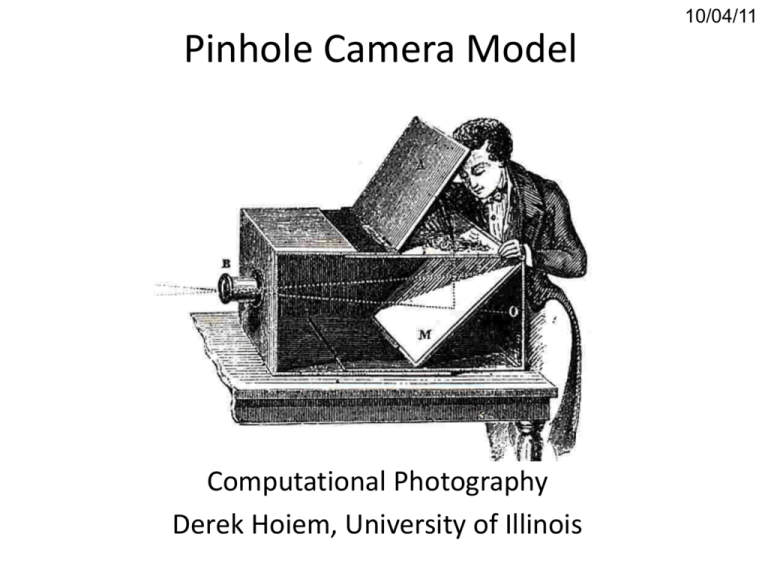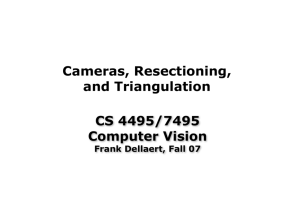ppt
advertisement

10/04/11 Pinhole Camera Model Computational Photography Derek Hoiem, University of Illinois Take photos for project 4 • >= 1024x1024, level, centered on face, blank background • Annotate your faces by 10/13, details to come Reminders • Project 3 due Monday • I’m out of town Wed to Fri • Amin Sadeghi is teaching Thurs: important and interesting stuff Next classes: Single-view Geometry How tall is this woman? How high is the camera? What is the camera rotation? What is the focal length of the camera? Which ball is closer? Today’s class Mapping between image and world coordinates – Pinhole camera model – Projective geometry • Vanishing points and lines – Projection matrix Image formation Let’s design a camera – Idea 1: put a piece of film in front of an object – Do we get a reasonable image? Slide source: Seitz Pinhole camera Idea 2: add a barrier to block off most of the rays – This reduces blurring – The opening known as the aperture Slide source: Seitz Pinhole camera f c f = focal length c = center of the camera Figure from Forsyth Camera obscura: the pre-camera • First idea: Mo-Ti, China (470BC to 390BC) • First built: Alhacen, Iraq/Egypt (965 to 1039AD) Illustration of Camera Obscura Freestanding camera obscura at UNC Chapel Hill Photo by Seth Ilys Camera Obscura used for Tracing Lens Based Camera Obscura, 1568 First Photograph Oldest surviving photograph – Took 8 hours on pewter plate Joseph Niepce, 1826 Photograph of the first photograph Stored at UT Austin Niepce later teamed up with Daguerre, who eventually created Daguerrotypes Dimensionality Reduction Machine (3D to 2D) 3D world 2D image Point of observation Figures © Stephen E. Palmer, 2002 Projection can be tricky… Slide source: Seitz Projection can be tricky… Slide source: Seitz Projective Geometry What is lost? • Length Who is taller? Which is closer? Length is not preserved A’ C’ B’ Figure by David Forsyth Projective Geometry What is lost? • Length • Angles Parallel? Perpendicular? Projective Geometry What is preserved? • Straight lines are still straight Vanishing points and lines Parallel lines in the world intersect in the image at a “vanishing point” Vanishing points and lines Vanishing Point Vanishing Line o Vanishing Point o Vanishing points and lines Vertical vanishing point (at infinity) Vanishing line Vanishing point Credit: Criminisi Vanishing point Vanishing points and lines Photo from online Tate collection Vanishing objects Projection: world coordinatesimage coordinates . Optical Center (u0, v0) . . v u u p v f . Camera Center (tx, ty, tz) Z Y X P Y Z Homogeneous coordinates Conversion Converting to homogeneous coordinates homogeneous image coordinates homogeneous scene coordinates Converting from homogeneous coordinates Homogeneous coordinates Invariant to scaling x kx kx x kw w k y ky ky y w kw kw w Homogeneous Coordinates Cartesian Coordinates Point in Cartesian is ray in Homogeneous Basic geometry in homogeneous coordinates ai • Line equation: ax + by + c = 0 line i bi ci • Append 1 to pixel coordinate to get ui homogeneous coordinate pi vi 1 • Line given by cross product of two points line ij pi p j • Intersection of two lines given by cross product of the lines qij linei line j Another problem solved by homogeneous coordinates Intersection of parallel lines Cartesian: (Inf, Inf) Homogeneous: (1, 1, 0) Cartesian: (Inf, Inf) Homogeneous: (1, 2, 0) Slide Credit: Saverese Projection matrix R,T jw kw Ow iw x KR t X x: Image Coordinates: w(u,v,1) K: Intrinsic Matrix (3x3) R: Rotation (3x3) t: Translation (3x1) X: World Coordinates: (X,Y,Z,1) Interlude: when have I used this stuff? When have I used this stuff? Object Recognition (CVPR 2006) When have I used this stuff? Single-view reconstruction (SIGGRAPH 2005) When have I used this stuff? Getting spatial layout in indoor scenes (ICCV 2009) When have I used this stuff? Inserting photographed objects into images (SIGGRAPH 2007) Original Created When have I used this stuff? Inserting synthetic objects into images: http://vimeo.com/28962540 Projection matrix Intrinsic Assumptions Extrinsic Assumptions • No rotation • Unit aspect ratio • Optical center at (0,0) • No skew x KI 0 X Slide Credit: Saverese • Camera at (0,0,0) K u f wv 0 1 0 0 f 0 x 0 0 y 0 0 z 1 0 1 Remove assumption: known optical center Intrinsic Assumptions Extrinsic Assumptions • No rotation • Unit aspect ratio • No skew x KI 0 X • Camera at (0,0,0) u f wv 0 1 0 0 u0 f v0 0 1 x 0 y 0 z 0 1 Remove assumption: square pixels Intrinsic Assumptions Extrinsic Assumptions • No skew x KI 0 X • No rotation • Camera at (0,0,0) u wv 0 1 0 0 u0 v0 0 1 x 0 y 0 z 0 1 Remove assumption: non-skewed pixels Intrinsic Assumptions Extrinsic Assumptions • No rotation • Camera at (0,0,0) x KI 0 X u wv 0 1 0 s u0 v0 0 1 Note: different books use different notation for parameters x 0 y 0 z 0 1 Oriented and Translated Camera R jw t kw Ow iw Allow camera translation Intrinsic Assumptions Extrinsic Assumptions • No rotation x KI t X u wv 0 1 0 0 0 x u0 1 0 0 t x y v0 0 1 0 t y z 1 0 0 1 t z 1 Slide Credit: Saverese 3D Rotation of Points Rotation around the coordinate axes, counter-clockwise: 0 1 Rx ( ) 0 cos 0 sin p’ y z p sin cos cos 0 sin R y ( ) 0 1 0 sin 0 cos cos sin 0 Rz ( ) sin cos 0 0 0 1 0 Allow camera rotation x KR t X u wv 0 1 0 s 0 u0 r11 r12 v0 r21 r22 1 r31 r32 r13 r23 r33 x tx y ty z t z 1 Degrees of freedom x KR t X 5 u wv 0 1 0 6 s 0 u0 r11 r12 v0 r21 r22 1 r31 r32 r13 r23 r33 x tx y ty z t z 1 Vanishing Point = Projection from Infinity x xR x y p KR t p KR y p K y R z z R z 0 u f wv 0 1 0 0 f 0 u0 xR v0 y R 1 z R fxR u u0 zR fyR v v0 zR Orthographic Projection • Special case of perspective projection – Distance from the COP to the image plane is infinite Image World – Also called “parallel projection” u 1 0 0 0 x y – What’s the projection matrix? v 0 1 0 0 w z 0 0 0 1 1 Slide by Steve Seitz Scaled Orthographic Projection • Special case of perspective projection – Object dimensions are small compared to distance to camera u f – Also called “weak perspective” v 0 – What’s the projection matrix? w 0 Illustration from George Bebis 0 f 0 x 0 0 y 0 0 z 0 s 1 Slide by Steve Seitz Take-home question Suppose we have two 3D cubes on the ground facing the viewer, one near, one far. 1. What would they look like in perspective? 2. What would they look like in weak perspective? Photo credit: GazetteLive.co.uk Beyond Pinholes: Radial Distortion Corrected Barrel Distortion Image from Martin Habbecke Things to remember Vanishing line • Vanishing points and vanishing lines • Pinhole camera model and camera projection matrix Vanishing point Vertical vanishing point (at infinity) Vanishing point x KR t X Next two classes • Thurs – Fun with faces, with Amin Sadeghi • Tues – Single-view geometry: recovering size in the world – Tricks with focus and aperture, Vertigo effect Questions




